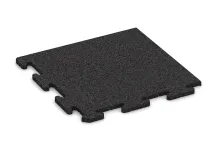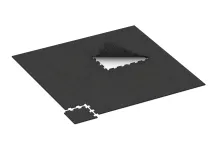Dog sports floor HD BZ "Anthracite"
- /
-
Delivery in approx.
7-14 days - €44.20 / 1 Piece / m²
- (16.32 kg / Piece)
EAN: 4251469339590 | Item no.: 3959
WARCO’s Dog sports floor HD has been designed for areas where dogs train hard every day or compete at high level. In agility halls, training centres or during competitions – wherever power, speed and precision matter – this grippy and slightly resilient surface delivers stability and safety. Its high density makes it exceptionally durable and abrasion-resistant, perfectly suited to the demands of modern dog sport.
Material and structure
The floor comes in two versions: made entirely from PU-bonded ELT rubber granulate (ELT = End of Life Tyres) or in a two-layer design with an EPDM rubber wear layer. The EPDM surface is through-coloured, UV-stable and colourfast. It is free from harmful substances and completely safe for direct skin or paw contact. Compared with the standard dog floor, the denser HD version is more abrasion-resistant, less permeable to liquids and slightly less elastic – while offering the same secure grip.
Formats and thicknesses
Available in 50 × 50 cm and 100 × 100 cm formats and in 1.8 cm (BZ) and 3 or 4 cm (TZ) thicknesses. All versions are intended for indoor use but can also be deployed temporarily at outdoor events. They can be laid quickly without tools and, once the event is over, cleaned, lifted and stored or transported for reuse.
Benefits and properties
The dense material extends service life and slows down liquid penetration (e.g. urine), which improves hygiene and simplifies cleaning. Tiles can be cleaned dry, damp or mechanically – vacuumed, hosed down with a pressure washer or disinfected with suitable cleaning agents. The slightly textured, grippy surface provides dogs with reliable traction – essential for fast movements and tight turns in sports and agility.
Installation
The all-round puzzle interlock connects the tiles securely to form a closed surface. Even without adhesive, the flooring remains dimensionally stable. It can be installed on solid bases, levels out small irregularities and, for outdoor events, can even be laid on a well-prepared grass surface. If required, tiles can be cut to size on site with a sharp knife, jigsaw or circular saw.
Discount
Product Highlights
Characteristics
Product Details – Material and Structure
Comparative values
To calculate how many tiles you need for your project, simply use the online installation planner available in the shop. This free browser-based tool is directly accessible on each product page – just below the price and quantity selection. Click on “Plan installation” to open the tool instantly – no registration or download required.
Enter the dimensions of your area, such as the length and width in metres. The planner will then automatically calculate the total number of tiles required, including a realistic allowance for offcuts. You’ll also be shown a suitable layout pattern for the selected product. The tool is user-friendly, accurate and ideal for planning your material requirements with confidence.
Yes, that is the standard approach. The vast majority of our customers – whether private, municipal, or commercial – install the delivered WARCO tiles themselves or with their own staff. The installation is simple and requires no special skills. Only fitting the curb into a concrete foundation with back support demands a little extra craftsmanship. Cutting the elements to size and laying them on a suitable substrate is not challenging. You can find all essential installation information in our Expert Advice – FAQ section on our website.
WARCO offers several connection systems for floor tiles, each differing in design, installation method and visual appearance. Below is an overview of the key differences:
Puzzle joint (visible)
In this system, the tile edges feature an interlocking profile reminiscent of classic jigsaw teeth or mushroom-shaped connectors. During installation, the profiles of adjacent tiles interlock to form a continuous connection across the full tile thickness.
The joint profile may be formed directly during pressing or precisely cut after the tile has cured. Whether the joint is visible in the finished surface depends on the edge finish (e.g. with or without chamfer) and the surface colouration.
The symmetrical shape ensures uniform load transfer and makes this type of joint the most mechanically stable option.
Plug-in connectors (plastic dowels)
This system uses separate connecting elements, typically round plastic dowels, which are inserted into pre-drilled holes along the sides of the tiles. The tiles themselves have smooth, straight edges similar to precast concrete slabs.
Installation is carried out in a half-bond (stretcher bond) pattern: each tile is connected via dowels to two tiles in the row above and two in the row below. This prevents lateral shifting, although some movement along the length of the dowels remains possible. For this reason, an edge restraint must be installed around the perimeter to stabilise the entire area.
Concealed puzzle joint
This method is based on the same mechanical principle as the classic puzzle joint, but is designed to be invisible in the finished surface. The interlocking profile is located on the underside of the tile, integrated into a rebated step joint.
Two tile edges feature a positive locking profile, the other two a matching negative profile. When laid, the tiles interlock securely from below, forming a durable mechanical connection. From above, the surface appears seamless and aligned, typically with a clean, square joint pattern similar to a chessboard layout.














































